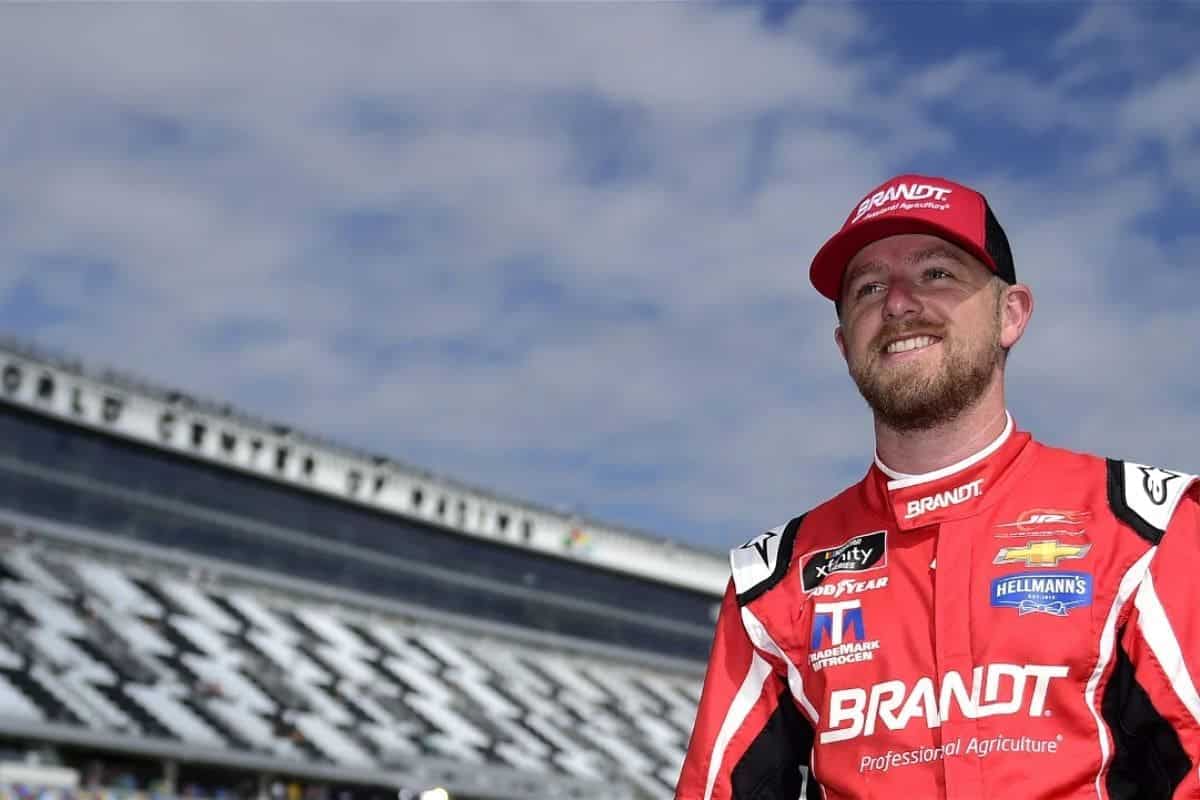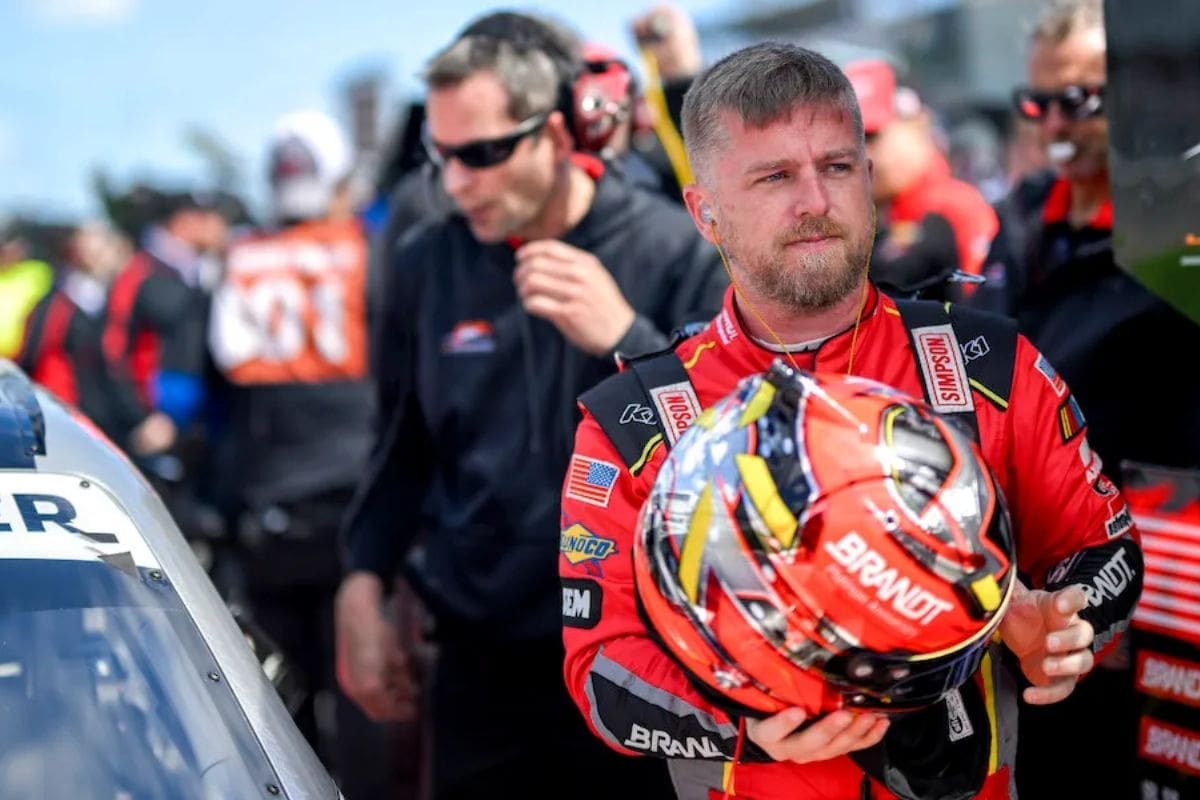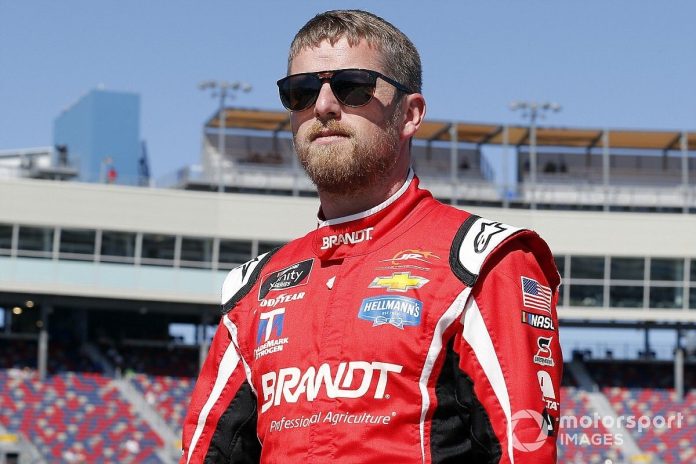Justin Allgaier Talladega Wreck: The harrowing crash involving Justin Allgaier at the NASCAR season opener in Talladega has reignited concerns about the dangers of superspeedway racing. This incident, occurring amidst tightly packed, high-speed laps, not only ended Allgaier’s race prematurely but also raised probing questions about the efficacy of current safety measures and racing protocols. While NASCAR has made significant strides in enhancing driver safety, the collision between Allgaier and Riley Herbst underlines a critical need for ongoing evaluation and adjustment of racing strategies and vehicle dynamics. The motorsport community grapples with striking a balance between competitive racing and safety imperatives as the dust settles. What will this mean for the future of driver safety standards and regulations in high-stakes environments like Talladega?
Key Takeaways
- Justin Allgaier’s race at Talladega ended abruptly due to a collision with Riley Herbst.
- The crash underscored the perilous nature of high-speed pack racing at Talladega.
- Allgaier criticized the current racing package for increasing the risks and complexities on the track.
- Despite the incident, Allgaier absolved Herbst of blame, highlighting the unpredictable nature of superspeedway racing.
- The wreck sparked discussions on the need for balancing technological advances with driver safety in NASCAR.
Justin Allgaier’s Crash Ends His Race at Talladega
Justin Allgaier’s participation in the Xfinity Series at Talladega Superspeedway concluded abruptly when his No. 7 Chevrolet collided with Riley Herbst’s vehicle, resulting in a devastating crash into the wall. This incident, occurring in one of NASCAR’s most unpredictable venues, not only highlights the inherent risks associated with high-speed, pack-style racing but also underscores the pivotal role of split-second decisions and spatial awareness in motorsport safety.
Analyzing the dynamics of the crash, it’s evident that Allgaier’s trajectory was severely compromised by the sudden lateral displacement of Herbst’s car. Such interactions, particularly at Talladega, amplify the challenges drivers face in maintaining control while maneuvering through tightly packed fields at speeds often exceeding 190 miles per hour. The aerodynamic interplay between cars, known as ‘drafting’, can lead to unexpected movements, making high-speed stability a critical but elusive asset.
In this specific instance, the force of impact not only terminated Allgaier’s race but also had broader implications for his standing in the series. Given the competitive nature of the Xfinity Series, each race is critical for accumulating points towards the championship. An early exit not only affects a driver’s points tally but can also have psychological impacts, influencing performance in subsequent races.
View this post on Instagram
This incident serves as a stark reminder of the fine margins that define success and failure in NASCAR. It also highlights the importance of continuous improvements in automotive safety technologies and the training regimes for drivers who must react instinctively to unpredictable, high-stress situations on the track. Understanding and mitigating these risks is crucial for advancing safety standards and protecting the well-being of the drivers who entertain millions.

Chaos at Talladega: Allgaier’s Early Exit
The end of stage 1 at Talladega was marked by a dramatic turn of events, as Justin Allgaier’s pursuit of a favorable track position culminated in a collision that abruptly ended his participation in the race. As competitors maneuvered for position, the high-speed environment of Talladega, notorious for its capacity to generate multi-car accidents, claimed its latest victim. Allgaier, who had been strategically working his way through the pack, found himself in an untenable situation that led to his early exit.
This incident is a stark reminder of the inherent risks associated with high-speed oval racing, particularly at a track as unpredictable as Talladega. The crash not only halted Allgaier’s ambitions for the day but also underscored the precarious balance between aggressive racing and strategic planning.
- Positional Risks: Allgaier’s attempt to improve his track position was a calculated risk that unfortunately did not pay off, highlighting the thin line between success and disaster in NASCAR racing.
- Track Dynamics: Talladega’s unique high-speed, high-banked layout contributes to the frequent occurrence of tightly packed groups, increasing the likelihood of crashes.
- Strategic Implications: The incident reveals the critical importance of timing and positioning in stage-based racing, where each segment can dramatically influence the final outcome.
- Safety Considerations: Each crash at such speeds serves as a critical data point for ongoing discussions about safety measures and vehicle durability in the face of high-impact collisions.
Analyzing such events provides valuable insights into the decision-making processes under extreme conditions and helps refine strategies for future races, ensuring drivers can better navigate the complexities of NASCAR’s most challenging tracks.
Allgaier Questions Racing Package After Talladega Crash
In the aftermath of his premature departure from the race at Talladega, Allgaier voiced significant criticisms regarding the current racing package, citing its complexities and the increased risk it posed during competition. He highlighted issues with maneuverability and the strategic challenges engendered by the package under high-speed, high-stakes conditions. This critique brings to light a broader conversation about the balance between technological advancement and driver safety in the high-octane world of NASCAR racing.
Allgaier’s concerns were not merely about the physical mechanics of the cars but also about the inherent racing strategies that these mechanics necessitate. The package in question is designed to increase competition by tightening the field, thereby amplifying the spectacle for fans. However, Allgaier’s feedback suggests a possible oversight in how these alterations affect race dynamics, particularly at a track as demanding as Talladega. His critique invites a reevaluation of whether the thrill for spectators inadvertently escalates the peril for drivers.
Furthermore, the Talladega incident underscores the necessity for continuous dialogue between drivers, technicians, and governing bodies to guarantee that the evolution of racing technologies aligns with the paramount objective of driver safety. It also raises questions about the adequacy of testing new racing packages in diverse track conditions and configurations.

No Foul Play: Allgaier on Crash with Herbst
Addressing another aspect of the Talladega incident, Justin Allgaier absolved Riley Herbst of any blame for their collision, underscoring the unpredictable nature of superspeedway racing. This perspective is vital in understanding the dynamics at play in such high-speed, close-quarter environments. Allgaier’s exoneration of Herbst not only reflects a seasoned racer’s insight but also highlights the inherent risks and uncontrollable variables that define superspeedway events.
Superspeedway racing, characterized by high speeds and drafting, inherently increases the likelihood of accidents. The drivers are often mere inches apart, traveling at speeds upwards of 200 miles per hour. In such settings, even the smallest miscalculation or the slightest shift in car handling due to aerodynamic forces can lead to major incidents. Therefore, Allgaier’s comments post-crash are not just about clearing Herbst but are an insightful commentary on the nature of the racing format itself.
To further understand the implications of Allgaier’s stance, consider the following points:
- Nature of Superspeedways: The tracks promote extremely close racing with high risks of multi-car accidents.
- Skill and Experience: Even veteran drivers acknowledge the role of chance in these races, reducing the stigma of blame in crashes.
- Sportsmanship and Professionalism: Allgaier’s approach fosters a supportive environment among drivers, crucial for mental resilience in competitive racing.
- Learning and Adaptation: Each incident provides valuable data for teams and drivers to strategize and improve safety measures.
Allgaier’s viewpoint serves as a reminder of the complexities and unpredictable elements in NASCAR racing, emphasizing that sometimes, incidents are just an unfortunate part of the sport’s nature. This insight allows fans and fellow racers alike to appreciate the challenges drivers face and the professionalism with which they handle them.
JRM Driver Allgaier Defends Herbst After Talladega Crash
Following the tumultuous events at Talladega, Justin Allgaier publicly defended Riley Herbst, emphasizing the unpredictable nature of superspeedway racing and expressing a desire to put the incident behind them. Allgaier’s response is pivotal, reflecting a seasoned racer’s understanding of the inherent risks and randomness associated with high-speed, high-density racing environments like Talladega. Such tracks are notorious for their ‘big one’—multi-car wrecks that can occur when drivers are mere inches apart at speeds exceeding 200 mph.
Allgaier’s defense of Herbst underscores a professional maturity and an unwritten rule in motorsports: racing incidents are often unavoidable. This perspective not only fosters a supportive atmosphere among drivers but also helps maintain focus on future races rather than dwelling on past misfortunes. Allgaier’s stance may also influence how teams, sponsors, and fans perceive such incidents, highlighting the importance of solidarity in the face of adversity.
Here’s a quick look at some key aspects of superspeedway racing dynamics:
| Aspect | Impact on Racing Dynamics |
|---|---|
| High Speeds | Increases accident severity |
| Close Proximity | Higher chance of chain reaction crashes |
| Aerodynamics | Drafting can lead to unstable car behavior |
| Unpredictability | Difficulty in consistently predicting outcomes |
Analytically, Allgaier’s comments reflect a deep understanding of the stochastic nature of motorsport events on superspeedways. His defense suggests a broader strategy of resilience and readiness, essential for enduring the psychological and physical demands of NASCAR racing. As the season progresses, this incident will likely serve as a reminder of the thin line between triumph and disaster in such high-stake races.

News in Brief: Justin Allgaier Talladega Wreck
The incident at Talladega involving Justin Allgaier underscores the perils inherent in NASCAR’s superspeedway events. This crash not only ended Allgaier’s race prematurely but also sparked discussions about the adequacy of current racing packages in enhancing safety.
The collision serves as a poignant reminder of the constant need for technological and strategic advancements in motorsport safety protocols. It also exemplifies the sportsmanship and professionalism within the racing community, as evidenced by Allgaier’s defense of Herbst post-collision.
Our Reader’s Queries
Q: What car does Justin Allgaier drive?
A:Justin Allgaier, an American racecar driver, is a prominent figure in the NASCAR Xfinity Series. He pilots the No. 7 Chevrolet Camaro for JR Motorsports, showcasing his talent and determination on the track.
Q: Is Justin Allgaier still racing?
A: Justin Allgaier is a full-time contender in the NASCAR Xfinity Series with JR Motorsports, steering the No. 7 Chevrolet. His prowess shone bright with his 23rd Xfinity victory, secured at Martinsville Speedway in October 2023.
Also Read: Justin Allgaier Four-Time Victory: Dominance as NASCAR Xfinity Series Fan Favorite


